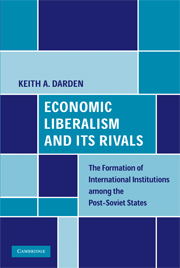 Economic Liberalism and Its Rivals
Economic Liberalism and Its Rivals Book contents
- Frontmatter
- Contents
- List of Figures and Tables
- Acknowledgments
- PART ONE THEORY AND METHODOLOGY
- 1 A Natural Experiment
- 2 A Theory of International Order
- 3 Three International Trajectories
- 4 Liberalism and Its Rivals: History, Typology, and Measurement
- PART TWO CONTINGENT SELECTION AND SYSTEMATIC EFFECTS: COUNTRY-LEVEL ANALYSES OF ELITE SELECTION, IDEATIONAL CHANGE, AND INSTITUTIONAL CHOICE, 1991–2000
- PART THREE COMPARING CASES
- Appendix A Measurement and Coding of Economic Ideas – Additional Tests
- Appendix B Interviews Conducted by the Author
- Bibliography
- Index
3 - Three International Trajectories
Published online by Cambridge University Press: 29 July 2009
- Frontmatter
- Contents
- List of Figures and Tables
- Acknowledgments
- PART ONE THEORY AND METHODOLOGY
- 1 A Natural Experiment
- 2 A Theory of International Order
- 3 Three International Trajectories
- 4 Liberalism and Its Rivals: History, Typology, and Measurement
- PART TWO CONTINGENT SELECTION AND SYSTEMATIC EFFECTS: COUNTRY-LEVEL ANALYSES OF ELITE SELECTION, IDEATIONAL CHANGE, AND INSTITUTIONAL CHOICE, 1991–2000
- PART THREE COMPARING CASES
- Appendix A Measurement and Coding of Economic Ideas – Additional Tests
- Appendix B Interviews Conducted by the Author
- Bibliography
- Index
Summary
The first step is to identify precisely what happened in the 10 years after the post-Soviet states became independent, i.e. to identify the variation in institutional choice. As discussed briefly in Chapter 1, the first post-Soviet decade brought marked differences in the institutions countries selected or created to manage their economic relations with other states, leading to three distinct international trajectories among countries in the region. One course was oriented to the pursuit of global multilateral liberalism – or nondiscriminatory and freer trade – exemplified by membership in the World Trade Organization. A second path led toward regionalism, or the active participation in economic institutions that privileged trade and economic ties among the former Soviet republics and sustained barriers to exchange with the rest of the world. The third road was toward autarky, or the reliance on national rather than international institutions for managing international economic exchange and the general closure of the economy through high tariffs, inconvertible currencies, or other restrictions.
Each of these institutional alternatives – the WTO, the CIS, and national autarky – entailed the adoption of a set of rules that significantly influenced international economic interaction and exchange, including rules governing the treatment of foreign enterprises, currency convertibility, the use of subsidiesm, and other aspects of the relationship between business and the state. Moreover, each alternative required that authority be allocated to a different set of decision-making institutions for establishing new sets of rules and standards related to international economic relations.
- Type
- Chapter
- Information
- Economic Liberalism and Its RivalsThe Formation of International Institutions among the Post-Soviet States, pp. 51 - 83Publisher: Cambridge University PressPrint publication year: 2009


